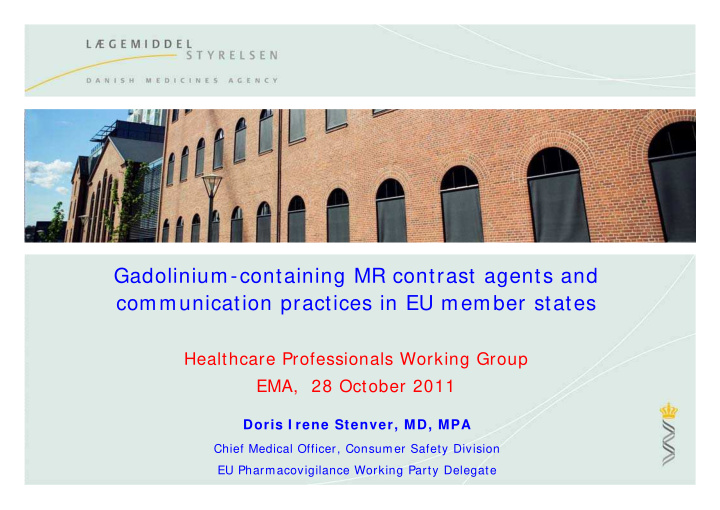



Gadolinium-containing MR contrast agents and communication practices in EU member states Healthcare Professionals Working Group EMA, 28 October 2011 Doris I rene Stenver, MD, MPA Chief Medical Officer, Consumer Safety Division EU Pharmacovigilance Working Party Delegate
Overview Introduction to the safety issue gadolinium and nephrogenic systemic fibrosis – what is the problem? Survey on communication practices in the EU – major findings List of questions to the HCP-WG – summary of responses Communication in 2012 – new initiatives 2
What is gadolinium (Gd) ? http: / / en.wikipedia.org/ wiki/ Gadolinium Rare silvery-white earth metal (64Gd) with paramagnetic properties, named after the Finnish chemist and geologist Johan Gadolin Constituent in many minerals; main mining areas China, US, Brazil, India, Australia; world production 400 tonnes per year No known native biological role, but is used as research tool in biomedicine; Gd 3+ component of Magnetic Resonance Imaging contrast agents 3
Gadolinium-based contrast media Approved indications Whole body MRI Cranial and spinal tomography Myocardial perfusion Renal transplant function Osteo-articular pathology Nine GdCAs marketed Low, medium and high risk products in relation to NSF 4
Nephrogenic Systemic Fibrosis Index case described in 2000 (Cowper, Lancet) Fibrosis in skin and inner organs Major clinical signs: Joint contractures, discoloration of skin, plaques, cobblestoning, peau d´ orange Major histopathological signs Increased cellularity (fibrocytes) Multiple differential diagnosis (dermatology, rheumatology) Renal insufficiency seems to be a prerequisite ! 5
What is the safety concern? Gadolinium is extremely toxic to human tissue In the MRI contrast media gadolinium is encapsulated (chelated) Hypothesis: In some patients gadolinium escapes the capsule (trans-metallation) and is deposited in the skin The gadolinium deposits activate / recruit fibrocytes 6
Survey on communication practices in the EU… . List of questions to member states – for details see back-up slides… Questions regarding tools, channels and timing Major findings are the following… . 7
Survey on communication practices Major findings The communication practice across the EU show some similarities, however is not completely harmonised. The communication initiatives vary both with respect to applied tools, channels and timing. Class communication is the favoured option, most often done on the initiative of the regulatory agency. All responding MSs published as minimum information on their website, and the agreed key elements were used. Website publication was supplemented with publications in national bulletins and / or communication sent to scientific societies. 8 Diversity with regard to the timing of the communication
LoQs to HCPWG 1. Please provide your general comments on the communication practice across the EU. 2. Please provide, in terms of appropriateness and strengths / weaknesses, your view on a. the applied tools (e.g. Direct Health Professional Communication letters, key messages) b. channels (e.g. website, national bulletin, via scientific societies) c. timing 3. Please provide proposals for ways of strengthening the communication practice. 9
LoQs to HCPWG cont. 4. In your view, where differential risk is identified across a class, are subsequent recommendations most usefully communicated in a single communication or as individual DHPCs? 5. In terms of promoting adherence to risk minimization measures, how important is awareness of the evidence for the risk assessment which underpins the recommendations? 6. In your view, are there particular challenges associated with the implementation of risk minimization measures targeted at special populations e.g. infants/ elderly? 10
Summary of responses from ESR and EULAR Preferred option – a combination of global letters directed to HCPs and sent by the regulatory authorities and publication on a few relevant websites In the Gd/ NSF case the communication was not entirely clear; still uncertainty regarding recommendations on renal function test Summary of Product Characteristics are not a suitable communication tool The evidence base for the proposed risk minimization measures should be provided No challenges foreseen with future use in children; some adults have denied examination with GdCA 11
Transparency and Communication New Initiatives Coordination of safety announcements Web portals Public hearings 12
PRAC and Transparency Regulation EU 1235/ 2010 states that in order to increase transparency as regards pharmacovigilance issues a European medicines web portal should be created and maintained by the Agency in collaboration with Members States and the Commission Agenda & Agenda & Minutes Minutes Assessments Decisions Opinions All available to the public! Agreements Positions Recommendations 13
. Thank you for your attention… 14
Recommend
More recommend